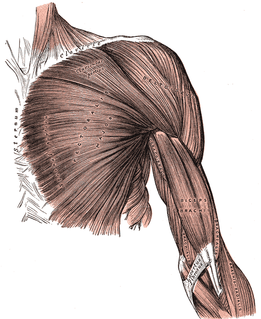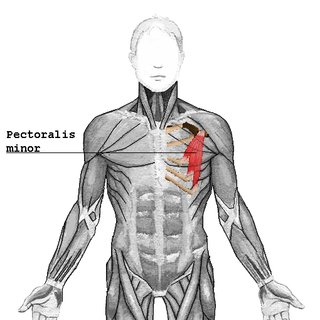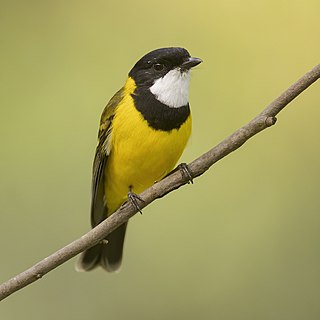
The coracoid process is a small hook-like structure on the lateral edge of the superior anterior portion of the scapula. Pointing laterally forward, it, together with the acromion, serves to stabilize the shoulder joint. It is palpable in the deltopectoral groove between the deltoid and pectoralis major muscles.

The bench press is an upper-body weight training exercise in which the trainee presses a weight upwards while lying on a weight training bench. The exercise uses the pectoralis major, the anterior deltoids, and the triceps, among other stabilizing muscles. A barbell is generally used to hold the weight, but a pair of dumbbells can also be used.

The pectoralis major is a thick, fan-shaped muscle, situated at the chest of the human body. It makes up the bulk of the chest muscles and lies under the breast. Beneath the pectoralis major is the pectoralis minor, a thin, triangular muscle. The pectoralis major's primary functions are flexion, adduction, and internal rotation of the humerus. The pectoral major may colloquially be referred to as "pecs", "pectoral muscle" or "chest muscle" due to it being the largest and most superficial muscle in the chest area.

The pectoralis minor is a thin, triangular muscle, situated at the upper part of the chest, beneath the pectoralis major in the human body.

Pectoral muscles are the muscles that connect the front of the human chest with the bones of the upper arm and shoulder.

The Australian golden whistler or golden whistler, is a species of bird found in forest, woodland, mallee, mangrove and scrub in Australia Most populations are resident, but some in south-eastern Australia migrate north during the winter. Its taxonomy is highly complex and remains a matter of dispute, with some authorities including as many as 59 subspecies of the golden whistler, while others treat several of these as separate species.

In human anatomy, the lateral thoracic artery is a blood vessel that supplies oxygenated blood to the lateral structures of the thorax and breast.

The subclavius is a small triangular muscle, placed between the clavicle and the first rib. Along with the pectoralis major and pectoralis minor muscles, the subclavius muscle makes up the Anterior Axioappendicular Muscles also known as anterior wall of the axilla.

The medial pectoral nerve arises from the medial cord of the brachial plexus and through it from the eighth cervical and first thoracic roots.

The lateral pectoral nerve arises from the lateral cord of the brachial plexus, and through it from the fifth, sixth, and seventh cervical nerves.

The clavipectoral fascia is a strong fascia situated under cover of the clavicular portion of the pectoralis major.

The pectoral fascia is a thin lamina, covering the surface of the pectoralis major, and sending numerous prolongations between its fasciculi: it is attached, in the middle line, to the front of the sternum; above, to the clavicle; laterally and below it is continuous with the fascia of the shoulder, axilla, and thorax.
The white-ankled mouse is a species of rodent in the family Cricetidae.
Nephelomys pectoralis is a species of rodent in the genus Nephelomys of family Cricetidae. Its type locality is 40 miles (64 km) west of the city of Popayán, Cauca Department, Colombia, at an altitude of 10,340 feet (3,150 m). American zoologist Joel Asaph Allen first described it in 1912 on the basis of 112 specimens from several locations in the Cordillera Occidental. He classified it as a species of Oryzomys, Oryzomys pectoralis, but later subsumed into the species Oryzomys albigularis. When that species was transferred to the new genus Nephelomys in 2006, N. pectoralis was recognized as a separate species.
Abanycha is a genus of longhorn beetles of the subfamily Lamiinae, containing the following species:
Abanycha bicolor is a species of beetle in the family Cerambycidae. It was described by Gahan in 1889. It is known from Ecuador.
Abanycha fasciata is a species of beetle in the family Cerambycidae. It was described by Galileo and Martins in 2005. It is known from Venezuela.
Abanycha pulchricollis is a species of beetle in the family Cerambycidae. It was described by Henry Walter Bates in 1885. It is known from Guatemala.
Abanycha sericipennis is a species of beetle in the family Cerambycidae. It was described by Henry Walter Bates in 1885. It is known from Costa Rica and Panama.
Abanycha urocosmia is a species of beetle in the family Cerambycidae. It was described by Henry Walter Bates in 1881. It is known from Colombia.







